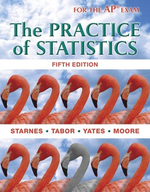Solution Found!
Solution: Section I: Multiple Choice Choose the best answer for Questions AP1.1 to
Chapter 4, Problem AP1.10(choose chapter or problem)
Section I: Multiple Choice Choose the best answer for Questions AP1.1 to AP1.14.
The General Social Survey (GSS), conducted by the National Opinion Research Center at the University of Chicago, is a major source of data on social attitudes in the United States. Once each year, 1500 adults are interviewed in their homes all across the country. The subjects are asked their opinions about sex and marriage, attitudes toward women, welfare, foreign policy, and many other issues. The GSS begins by selecting a sample of counties from the 3000 counties in the country. The counties are divided into urban, rural, and suburban; a separate sample is chosen at random from each group. This is a
(a) simple random sample.
(b) systematic random sample.
(c) cluster sample.
(d) stratified random sample.
(e) voluntary response sample.
Questions & Answers
QUESTION:
Section I: Multiple Choice Choose the best answer for Questions AP1.1 to AP1.14.
The General Social Survey (GSS), conducted by the National Opinion Research Center at the University of Chicago, is a major source of data on social attitudes in the United States. Once each year, 1500 adults are interviewed in their homes all across the country. The subjects are asked their opinions about sex and marriage, attitudes toward women, welfare, foreign policy, and many other issues. The GSS begins by selecting a sample of counties from the 3000 counties in the country. The counties are divided into urban, rural, and suburban; a separate sample is chosen at random from each group. This is a
(a) simple random sample.
(b) systematic random sample.
(c) cluster sample.
(d) stratified random sample.
(e) voluntary response sample.
ANSWER:Step 1 of 2
Simple random sampling uses a sample of size in which every sample of size
has an equal chance of being chosen.
Stratified random sampling draws simple random samples from independent subgroups (stratum).
Cluster sampling divides the population into non-overlapping subgroups (clusters) and some of these subgroups are then in the sample.
Systematic random sampling is letting every th individual be in the sample (
an integer).
A voluntary response sample is a sample for which the subjects can decide if they want to be in the sample or not.
